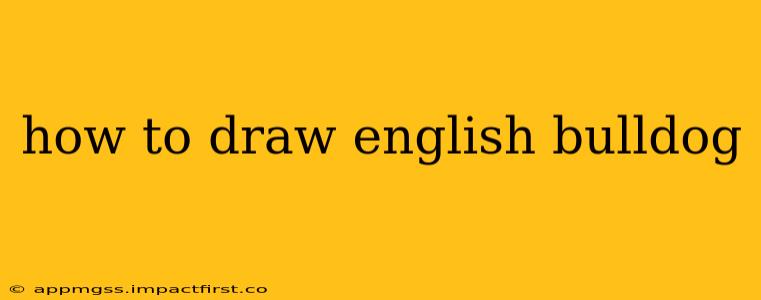The English Bulldog, with its distinctive wrinkled face and stocky build, is a beloved breed that's a joy to draw. This guide will walk you through the process, breaking it down into manageable steps, whether you're a beginner or a more experienced artist. We'll cover different approaches, addressing common questions along the way.
Getting Started: Materials and Basic Shapes
Before we begin, gather your materials. You'll need:
- Paper: Sketch paper or drawing paper works well.
- Pencils: A range of pencils (HB, 2B, 4B) will allow for varying line weights and shading. A kneaded eraser is also helpful for precise corrections.
- Eraser: A good quality eraser is essential for removing mistakes.
- Reference Image: Finding a clear, high-quality photo of an English Bulldog is crucial. This will serve as your guide throughout the drawing process.
Now, let's start with basic shapes:
- Head: Begin by sketching a rough circle for the head.
- Body: Add a slightly elongated oval underneath the circle for the body, connecting them smoothly. Think about the bulldog's compact and muscular build.
- Legs: Sketch four short, sturdy cylinders for the legs. English Bulldogs have relatively short legs.
- Tail: Add a short, curled tail.
Defining the Bulldog's Features: Step-by-Step
Now that we have the basic shapes, let's refine the features:
- Face: Divide the circle (head) into sections to help place the eyes, nose, and mouth. The English Bulldog's face is broad and flat. Sketch in the characteristic wrinkles around the eyes and nose.
- Eyes: English Bulldogs have small, dark eyes, set relatively far apart. Draw them as small ovals.
- Nose: The nose is large and broad, typically black. Draw it as a wide, slightly upturned triangle.
- Mouth: The mouth is usually slightly open, showing the lower jaw and teeth. Pay attention to the shape of the jawline, which is quite prominent in this breed.
- Ears: The ears are relatively small and rose-shaped, usually folded over. Sketch them lightly at first.
- Body Details: Define the chest, back, and belly. English Bulldogs are muscular but not overly lean.
- Legs and Feet: Refine the shapes of the legs and add small, rounded feet.
Adding Details and Shading: Bringing Your Bulldog to Life
Once you're happy with the basic form, start adding details:
- Wrinkles: Carefully refine the wrinkles on the face and around the neck. This is what gives the Bulldog its unique character.
- Fur: While short, the coat of an English Bulldog has texture. Use light hatching or cross-hatching to suggest the fur.
- Shading: Use shading to add depth and dimension to your drawing. Pay attention to the light source and how it affects the form of the Bulldog's body. Darker shading can be used to emphasize the wrinkles and folds.
H2: What are the key characteristics of an English Bulldog's face?
The key characteristics of an English Bulldog's face include its broad, short muzzle; prominent underjaw; wrinkled forehead; small, dark eyes set far apart; and large, broad nose (often black). These features contribute to the breed's unique and expressive appearance.
H2: How do I draw the wrinkles on an English Bulldog's face?
Drawing the wrinkles is crucial for capturing the breed's distinctive look. Start with lighter lines to map out the general areas of the wrinkles. Gradually build up the wrinkles using layered lines, varying the darkness and thickness to create depth and form. Observe reference photos closely to understand how the wrinkles fall and fold.
H2: What are some common mistakes when drawing English Bulldogs?
Common mistakes include: drawing the muzzle too long or pointed; not emphasizing the wrinkles sufficiently; making the eyes too large or too close together; and failing to capture the breed's stocky, muscular build. Using reference photos and practicing regularly will help you avoid these common pitfalls.
Practice Makes Perfect!
Drawing an English Bulldog takes practice. Don't be discouraged if your first attempt isn't perfect. Keep practicing, experiment with different techniques, and observe your reference image carefully. The more you practice, the better you'll become at capturing the unique features and personality of this beloved breed. Remember to have fun!
